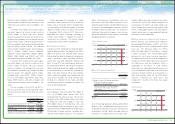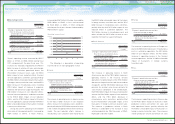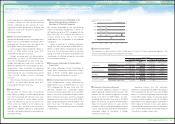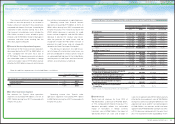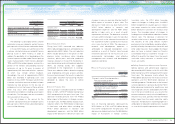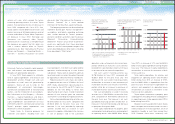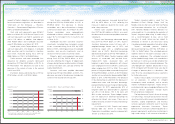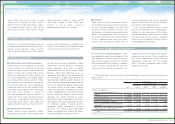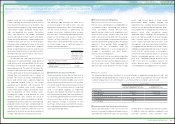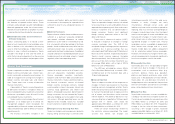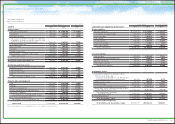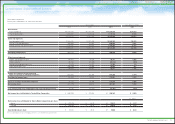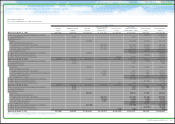Toyota 2011 Annual Report Download - page 62
Download and view the complete annual report
Please find page 62 of the 2011 Toyota annual report below. You can navigate through the pages in the report by either clicking on the pages listed below, or by using the keyword search tool below to find specific information within the annual report.
Outlook
0822
Financial Section and
Investor Information
Business and
Performance Review
Special FeatureMessage/Vision
Management and
Corporate Information
Management's Discussion and Analysis of Financial Condition and Results of Operations
The automotive operations segment is Toyota’s
largest operating segment by net revenues. Net
revenues for the automotive segment decreased
during fiscal 2010 by ¥1,367.3 billion, or 7.4%,
compared with the prior year to ¥17,197.4 billion.
The decrease was primarily due to fluctuations in
foreign currency translation rates of ¥886.5 billion
and decreased vehicle unit sales and the changes
in sales mix of approximately ¥570.0 billion, partially
offset by increased parts sales of ¥34.9 billion.
Operating loss from the automotive operations
decreased by ¥308.5 billion during fiscal 2010
compared with the prior year to an operating loss
of ¥86.3 billion. This decrease in operating loss
was primarily due to the ¥520.0 billion impact of
cost reduction efforts, the ¥470.0 billion decrease
in fixed costs, the ¥23.7 billion impact of increase
in parts sales, and other efforts, partially offset by
a ¥380.0 billion decrease in vehicle unit sales and
changes in sales mix and the ¥320.0 billion effects
of changes in exchange rates.
The decrease in vehicle unit sales and
changes in sales mix was due primarily to a
decrease in vehicle unit sales by 330 thousand
vehicles which resulted from the generally difficult
market conditions in the automotive industry
during fiscal 2010 compared with the prior fiscal
year. The decrease in fixed costs was due mainly
to the ¥178.7 billion decline in research and
development expenses and the ¥62.7 billion
decline in labor costs, as a result of profit
improvement initiatives, partially offset by ¥105.7
billion increase in costs resulting from a change in
the estimation model of expenses related to future
recalls and other safety measures.
Net revenues for the financial services operations
decreased during fiscal 2010 by ¥132.1 billion, or
Ratio of credit loss experience in the United States is as follows:
Net revenues for Toyota’s other operations segment decreased by ¥237.3 billion, or 20.0%, to ¥947.6
billion during fiscal 2010 compared with the prior year.
Operating income from Toyota’s other operations segment decreased by ¥18.8 billion, to operating
loss of ¥8.9 billion during fiscal 2010 compared with the prior year.
9.6%, compared with the prior fiscal year to
¥1,245.4 billion. This decrease was primarily due
to the unfavorable impact of fluctuations in foreign
currency translation rates of ¥93.3 billion. Excluding
the difference in the Japanese yen value used for
translation purposes, net revenues for its financial
services operations would have been approximately
¥1,338.7 billion during fiscal 2010, a 2.8% decrease
compared with the prior fiscal year. The decrease
in net revenues excluding the difference in the
Japanese yen value used for translation purposes
of ¥93.3 billion resulted primarily from the
¥63.5 billion decrease in rental income from
vehicles and equipment on operating leases.
Operating income from financial services
operations increased by ¥318.9 billion to ¥246.9
billion during fiscal 2010 compared with the prior
year. This increase was primarily due to the ¥140.0
billion decrease in provision for credit losses, net
charge-offs, the ¥64.5 billion of the recognition of
valuation gains on interest rate swaps stated at
fair value, and the ¥50.0 billion decrease in
provision for residual value losses.
The decrease in provision for credit losses,
net charge-offs is primarily attributable to the
¥150.0 billion increase in provision for credit
losses and net charge-offs in the United States
primarily due to the 0.46% rise in the ratio of credit
losses as a result of the economic downturn in
the prior fiscal year, partially offset by the ¥37.3
billion impact from the recalls and other safety
measures. The decrease in provision for residual
value losses is primarily attributable to the
recovery in the used vehicle market, partially
offset by the impact from the recalls and other
safety measures. Toyota judges this impact does
not have a material impact on Toyota’s consolidated
financial statements though it is difficult to quantify
the impact from the recalls and other safety
measures in residual value losses accurately.
The decrease in residual value losses is
primarily attributable to the recovery in the used
vehicle market, as prices of used vehicles moved
from a historical low in fiscal 2009 to an
unprecedented high in fiscal 2010, partially offset
by the impact of increased sales incentives and
other factors.
Year ended March 31,
2009 2010
Net charge-offs as a percentage of average gross earning assets:
Finance receivables 1.54% 1.15%
Operating lease 0.86% 0.63%
Total 1.37% 1.03%
All Other Operations Segment
While Toyota expects that emerging countries,
such as China and India, will continue to experi-
ence economic growth, and that developed
countries, including those in North America and
Europe, will continue to see gradual economic
recovery in fiscal 2012, Toyota believes the impact
and risks arising from increases in the price of
crude oil, continuing high unemployment rate in
North America and Europe, and other factors
must be closely observed. Although Toyota
expects the automotive market to expand over
the medium- to long-term particularly in emerging
countries, the global competition in the automo-
tive market has intensified, as shown in the small
and low-price vehicles markets and in the
environmentally-friendly vehicles market. For
purposes of this outlook discussion, Toyota is
assuming an average exchange rate of ¥82 to the
U.S. dollar and ¥115 to the euro. With the foregoing
external factors in mind, Toyota expects that net
revenues for fiscal 2012 will decrease compared
with fiscal 2011 as a result of a decrease in vehicle
unit sales and the assumed exchange rate of a
stronger Japanese yen against the U.S. dollar in
fiscal 2012 compared with the prior fiscal year.
With respect to operating income, factors
increasing operating income include cost
reduction efforts. On the other hand, factors
decreasing operating income include the
assumed exchange rate of a stronger Japanese
yen against the U.S. dollar in fiscal 2012 compared
with the prior fiscal year as well as decreases in
Financial Services Operations Segment
Automotive Operations Segment
62TOYOTA ANNUAL REPORT 2011


